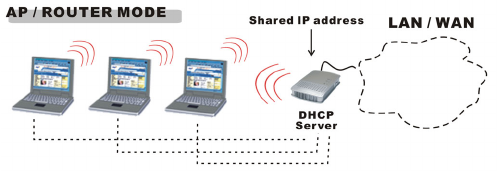
3
You can connect to the Travel Router using either the Wireless interface
or the wired Ethernet connection.
See the later section Initial Configuration for details.
Router Mode
In Router Mode, the Travel Router acts as a DHCP Server, allocating IP
addresses for Wireless stations (clients). It also acts as a Wireless NAT
Router with SPI/Firewall, sharing the IP address on the Ethernet
(LAN/WAN) port with all Wireless clients. (It has 2 IP addresses, one on the
LAN/WAN port and another on the Wireless LAN.)
When Should I use Router Mode? Use Router mode in any of these
situations:
■ The Ethernet port is connected to a Broadband modem rather than an
Ethernet port.
■ You want the wireless clients to be protected by the Travel Router's
SPI/Firewall.
■ You want the Travel Router to function as a DHCP server for the
Wireless clients.
■ You want the wireless clients to be in a separate network from the
network connected to the Ethernet port.
■ You have permission for ONLY ONE (1) user to connect to the LAN or
WAN, but you need to connect multiple users. (In Router mode, the IP
address on the Ethernet port is shared by all Wireless clients.)
When Should I NOT use Router Mode? You can always use Router
mode to establish a wireless connection to the LAN or WAN.
However, this mode uses a technology called NAPT (Network Address
Port Translation), and NAPT may cause problems with some complex
multi-user communication applications. (There is no problem with














